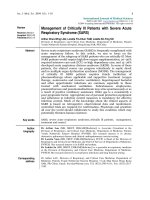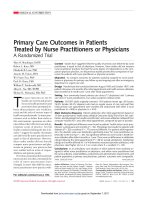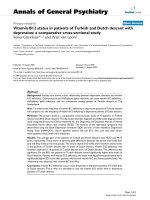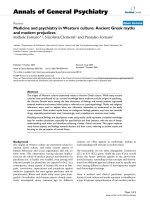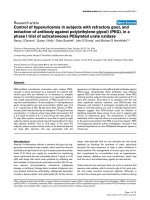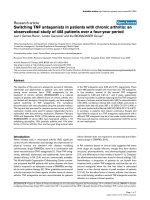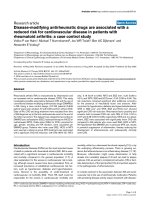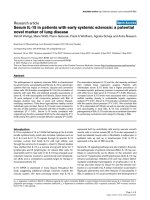Báo cáo y học: " Extravascular lung water in patients with severe sepsis: a prospective cohort study" doc
Bạn đang xem bản rút gọn của tài liệu. Xem và tải ngay bản đầy đủ của tài liệu tại đây (287.95 KB, 9 trang )
Open Access
Available online />R74
April 2005 Vol 9 No 2
Research
Extravascular lung water in patients with severe sepsis: a
prospective cohort study
Greg S Martin
1
, Stephanie Eaton
2
, Meredith Mealer
3
and Marc Moss
4
1
Director, Medical and Coronary Intensive Care Units, Grady Memorial Hospital, and Assistant Professor of Medicine, Division of Pulmonary, Allergy
and Critical Care, Emory University School of Medicine, Atlanta, Georgia, USA
2
Grady Memorial Hospital, Emory University School of Medicine, Division of Pulmonary and Critical Care Medicine, Atlanta, Georgia, USA
3
Senior Research Coordinator, Division of Pulmonary, Allergy and Critical Care, Emory University School of Medicine, Atlanta, Georgia, USA
4
Section Head, Pulmonary Allergy and Critical Care Medicine, Grady Memorial Hospital, and Associate Professor of Medicine, Division of Pulmonary,
Allergy and Critical Care, Emory University School of Medicine, Atlanta, Georgia, USA
Corresponding author: Greg S Martin,
Abstract
Introduction Few investigations have prospectively examined extravascular lung water (EVLW) in
patients with severe sepsis. We sought to determine whether EVLW may contribute to lung injury in
these patients by quantifying the relationship of EVLW to parameters of lung injury, to determine the
effects of chronic alcohol abuse on EVLW, and to determine whether EVLW may be a useful tool in the
diagnosis of acute respiratory distress syndrome (ARDS).
Methods The present prospective cohort study was conducted in consecutive patients with severe
sepsis from a medical intensive care unit in an urban university teaching hospital. In each patient,
transpulmonary thermodilution was used to measure cardiovascular hemodynamics and EVLW for 7
days via an arterial catheter placed within 72 hours of meeting criteria for severe sepsis.
Results A total of 29 patients were studied. Twenty-five of the 29 patients (86%) were mechanically
ventilated, 15 of the 29 patients (52%) developed ARDS, and overall 28-day mortality was 41%. Eight
out of 14 patients (57%) with non-ARDS severe sepsis had high EVLW with significantly greater
hypoxemia than did those patient with low EVLW (mean arterial oxygen tension/fractional inspired
oxygen ratio 230.7 ± 36.1 mmHg versus 341.2 ± 92.8 mmHg; P < 0.001). Four out of 15 patients with
severe sepsis with ARDS maintained a low EVLW and had better 28-day survival than did ARDS
patients with high EVLW (100% versus 36%; P = 0.03). ARDS patients with a history of chronic
alcohol abuse had greater EVLW than did nonalcoholic patients (19.9 ml/kg versus 8.7 ml/kg; P <
0.0001). The arterial oxygen tension/fractional inspired oxygen ratio, lung injury score, and chest
radiograph scores correlated with EVLW (r
2
= 0.27, r
2
= 0.18, and r
2
= 0.28, respectively; all P <
0.0001).
Conclusions More than half of the patients with severe sepsis but without ARDS had increased EVLW,
possibly representing subclinical lung injury. Chronic alcohol abuse was associated with increased
EVLW, whereas lower EVLW was associated with survival. EVLW correlated moderately with the
severity of lung injury but did not account for all respiratory derangements. EVLW may improve both
risk stratification and management of patients with severe sepsis.
Introduction
Severe sepsis is a common syndrome among hospitalized
patients, occurring at a rate of 250,000–750,000 cases/year
in the USA [1,2]. It is defined as pathologic infection
Received: 11 November 2004
Accepted: 23 November 2004
Published: 11 January 2005
Critical Care 2005, 9:R74-R82 (DOI 10.1186/cc3025)
This article is online at: />© 2005 Martin et al., licensee BioMed Central Ltd.
This is an Open Access article distributed under the terms of the
Creative Commons Attribution License ( />licenses/by/2.0), which permits unrestricted use, distribution, and
reproduction in any medium, provided the original work is cited.
AECC = American–European Consensus Conference; ANOVA = analysis of variance; APACHE = Acute Physiology and Chronic Health Evaluation;
ARDS = acute respiratory distress syndrome; CO = cardiac output; EVLW = extravascular lung water; FiO
2
= fractional inspired oxygen; GEDV =
global end-diastolic volume; ICU = intensive care unit; IQR = interquartile range; ITBV= intrathoracic blood volume; ITTV = intrathoracic thermal vol-
ume; LIS = Lung Injury Score; PaO
2
= arterial oxygen tension; PTV = pulmonary thermal volume.
Critical Care April 2005 Vol 9 No 2 Martin et al.
R75
accompanied by a spectrum of physiologic abnormalities,
originally described as systemic inflammatory response syn-
drome criteria in combination with acute organ dysfunction
[3,4]. Sepsis is associated with high death rates, killing 30–
50% of those severely afflicted [1,5], and is the leading cause
of death among patients in noncoronary intensive care units
(ICUs) in the USA [6]. According to the annual report from the
National Center for Health Statistics [7], sepsis has risen to
being the 10th leading cause of death overall in the USA.
Respiratory failure is among the most frequent complications
of severe sepsis, occurring in nearly 85% of cases [5]. The
mechanisms of acute lung failure in sepsis are complex and
incompletely understood [8]. The hallmark of sepsis is
increased capillary permeability, which manifests in the lungs
as altered alveolar–capillary barrier function and is character-
ized by accumulation of extravascular lung water (EVLW).
However, there is a paucity of data regarding EVLW in
patients with severe sepsis.
The most severe form of lung failure, acute respiratory distress
syndrome (ARDS), occurs in 40% of patients with sepsis [9].
As with sepsis, ARDS is a heterogeneous clinical syndrome.
Recognition of ARDS relies upon a clinical definition, which
was standardized in 1994 by the American–European Con-
sensus Conference (AECC) [9]. These criteria comprise a
constellation of clinical and radiographic findings that are
associated with varying degrees of reliability [10]. No previous
diagnostic criteria for ARDS have included measures of
EVLW.
A variety of pre-existing comorbid conditions may alter the inci-
dence and severity of ARDS. Chronic alcohol abuse is inde-
pendently associated with a doubling in risk for developing
ARDS, and once ARDS has developed it is associated with a
nearly twofold risk for dying [11]. Similarly, chronic alcohol
abuse is associated with more severe organ dysfunction in
patients with septic shock [12]. Animal models of chronic
alcohol abuse confirm the presence of steady-state abnormal-
ities in alveolar–capillary permeability [13]. Initial findings in
humans with chronic alcohol abuse suggest that alveolar–cap-
illary barrier function is persistently altered [14].
We hypothesized that acute respiratory failure accompanying
severe sepsis relates to subclinical abnormalities in capillary
permeability. If this is true, then these abnormalities would be
clinically apparent in the accumulation of EVLW across a
broad population of patients with severe sepsis. We con-
ducted the largest prospective evaluation to date of EVLW
among critically ill patients with severe sepsis. We also evalu-
ated the heterogeneity of EVLW in those patients who devel-
oped ARDS and the impact that chronic alcohol abuse had on
the accumulation of EVLW and respective outcomes.
Methods
This study was reviewed and approved by the Institutional
Review Board of Emory University School of Medicine. All
patients admitted to the Medical ICU at Grady Memorial Hos-
pital between July 2001 and March 2002 were screened for
eligibility. Included patients met standard published criteria for
severe sepsis [15]. The exclusion criteria were pregnancy,
contraindication to femoral artery catheterization, age less
than 18 years, and inability to obtain informed consent from
the patient or surrogate. All eligible patients were enrolled
within 72 hours of meeting criteria for severe sepsis. Patient
management decisions, including the type and amount of vol-
ume resuscitation, were at the discretion of the primary inten-
sive care physician.
At the time of enrollment, patient-specific data were obtained,
including demographic data, past medical and social history,
source of sepsis, and Acute Physiology and Chronic Health
Evaluation (APACHE) II score [16]. A 5-F arterial catheter (Pul-
siocath PV2015; Pulsion Medical Systems, Munich, Germany)
was placed in the descending aorta via the femoral artery
using the Seldinger technique. The arterial catheter and a
standard central venous catheter were connected to pressure
transducers and to an integrated bedside monitor (PiCCO;
Pulsion Medical Systems). Continuous cardiac output (CO)
calibration and EVLW measurements were obtained by tripli-
cate central venous injections of 15–20 ml iced 0.9% saline
solution. CO calibrations and determination of EVLW were
performed immediately after catheter insertion and at least
every 24 hours for 7 days. The catheter system was discontin-
ued before 7 days had elapsed in the event of patient death or
transfer from the ICU.
The PiCCO catheter system uses a single thermal indicator
technique to determine EVLW, CO, and volumetric parame-
ters. The bolus thermodilution CO is used to determine the
patient's aortic impedance, which is used to calibrate the con-
tinuous CO [17,18]. CO is calculated using the Stewart–
Hamilton method from thermodilution curves measured in the
descending aorta, with accuracy comparable with that of pul-
monary artery thermodilution [17-21]. The volume of distribu-
tion of the thermal indicator represents the intrathoracic
thermal volume (ITTV), where ITTV (ml) = CO × mean transit
time of the thermal indicator [22,23]. The pulmonary thermal
volume (PTV) is given by PTV (ml) = CO × τ, where τ is expo-
nential decay time of the thermodilution curve [24]. Global
end-diastolic volume (GEDV), the combined end-diastolic vol-
umes of all cardiac chambers, is given by ITTV – PTV (ml). This
permits calculation of intrathoracic blood volume (ITBV) from
the linear relationship with GEDV [22,25]: ITBV = 1.25 ×
GEDV – 28.4 (ml). EVLW is the difference between the ther-
mal indicator distribution in the chest (ITTV) and the blood vol-
ume of the chest (ITBV) [22,25-29]: EVLW = ITTV – ITBV (ml).
Available online />R76
Outcome variables
Parameters were indexed to total body surface area or to body
weight in order to facilitate comparisons (e.g. EVLW refers to
EVLWI). Patients were considered to have elevated EVLW if
any measurement was greater than 10 ml/kg, based on previ-
ous studies examining the range of EVLW measurements in
control patients with no clinical evidence of lung abnormalities
[30,31]. Patients were followed for 28 days from enrollment to
determine the occurrence of ARDS and death. ARDS was
deemed to be present when the AECC criteria [9] were met
within 7 days of developing severe sepsis. These criteria are
as follows: acute onset of hypoxemia (arterial oxygen tension
[PaO
2
]/fractional inspired oxygen [FiO
2
] ratio <200 mmHg)
with bilateral infiltrates on chest radiograph and pulmonary
artery occlusion pressure ≤ 18 mmHg or no evidence of left
atrial hypertension. The severity of ARDS was quantitated
using the Lung Injury Score (LIS) [32]. In addition, chest radi-
ograph score (number of quadrants with >50% involvement
with an alveolar filling process), PaO
2
/FiO
2
ratio, and ventilator
settings were recorded daily. The lung permeability index was
calculated as the ratio of EVLW to ITBV, which was previously
shown to reflect permeability of the alveolar–capillary barrier
[23,33]. Patients were considered to have a history of chronic
alcohol abuse if they had a history of alcohol abuse in their
medical records or had a score of at least 3 on the Short Mich-
igan Alcohol Assessment Test [34].
Statistical analysis
Data are presented as mean ± standard deviation, or as
median (interquartile range [IQR]), depending on the distribu-
tion normality of the variable. Continuous variable measure-
ments were compared using two-sample t-tests or Mann–
Whitney U-tests for normally or non-normally distributed data,
respectively. Multiple longitudinal comparisons were made by
repeated measures analysis of variance (ANOVA) with time as
a covariate. The χ
2
statistic was used to compare frequency
proportions. Modeling by least squares linear regression for
continuous outcome variables and maximum likelihood logistic
regression for dichotomous outcome variables was used to
assess individual effects while adjusting for individually signif-
icant covariables. Statistical analysis was performed using
NCSS 2001 software (NCSS, Inc., Kaysville, UT, USA) and all
statistical tests were two-sided. P = 0.05 was considered sta-
tistically significant and P > 0.20 is reported as not significant.
Results
Severe sepsis study population
Twenty-nine patients with severe sepsis were enrolled at a
median of 1 day after development of organ dysfunction
requiring ICU admission. Demographic and physiologic char-
acteristics are presented in Table 1. For 17 patients there
were complete data for all 7 days; the study was terminated
early because of patient death (n = 5) or transfer out of the
ICU (n = 7) in the remaining 12 patients. The sources of sepsis
were pneumonia (n = 16), intra-abdominal infection (n = 6),
primary bloodstream infection (n = 4), and urosepsis (n = 3).
The incidence of ARDS, according to the AECC definition,
was 52% (15/29). Chronic alcohol abuse was present in 13
out of 29 patients (45%). The overall 28-day mortality was
41% (12/29).
At the time of enrollment, the median EVLW for all patients
was 8.5 ml/kg (IQR 5.1–15.8 ml/kg). The mean PaO
2
/FiO
2
ratio was 222.3 ± 149.8 mmHg and LIS was 1.80 ± 1.34; the
median chest radiograph score was 2.0 (IQR 1.0–3.0). The
mean baseline GEDV index (normal: 680–800 ml/m
2
) was
681 ml/m
2
and the mean systemic vascular resistance index
(normal: 1800–2500 dyn·s/cm
5
per m
2
) was 1528 ± 562
dyn·s/cm
5
per m
2
. Fluid balance (net intake/output) was con-
sistently positive, with a cumulative mean during the study
period of 8932 ± 9527 ml. The cumulative median EVLW for
all patients over time was 9.0 ml/kg (IQR 6.5–15.2 ml/kg) and
the mean change in EVLW from the beginning of the study
period to the end was -1.1 ± 4.4 ml/kg. EVLW was greater in
nonsurvivors than in survivors from severe sepsis (14 ml/kg
[IQR 7.4–20 ml/kg] versus 8.0 ml/kg [IQR 5.9–11.2 ml/kg]; P
< 0.001), and death was associated with greater EVLW over
time (Fig. 1a; ANOVA P < 0.001). There were no significant
longitudinal differences in oxygenation between survivors and
nonsurvivors (Fig. 1b).
Correlates with extravascular lung water
We examined the relationship between measures of lung injury
and EVLW. Using the PaO
2
/FiO
2
ratio as a measure of oxy-
genation, we found a statistically significant but moderate cor-
relation with EVLW (r
2
= 0.27; P < 0.0001; Fig. 2a). Similar
relationships were observed between EVLW and the chest
radiograph score (r
2
= 0.28) and the LIS (r
2
= 0.18; both P <
0.0001). There was a significant correlation between the high-
est EVLW and lowest PaO
2
/FiO
2
ratio (r
2
= 0.32; P = 0.003),
which was greater in nonsurvivors (r
2
= 0.60; P = 0.005; Fig.
2b) than in survivors (r
2
= 0.13; P = 0.20). There was a poor
correlation between EVLW and GEDV index (r
2
= 0.11; P <
0.001) and no correlation between EVLW and either daily or
cumulative fluid balance.
Severe sepsis without acute respiratory distress
syndrome
The baseline characteristics and physiology of the patients
with severe sepsis without ARDS are presented in Table 1;
there were no differences in fluid balance or hydrostatic pres-
sure (GEDV index) between this subgroup and all severe sep-
sis patients combined. The median EVLW for the 14 non-
ARDS severe sepsis patients was 7.7 ml/kg (IQR 5.0–10.2
ml/kg), but it was above normal in 57% of patients (8/14;
Table 2). The median EVLW for non-ARDS patients with
increased EVLW was 12.0 ml/kg (IQR 11.0–14.0 ml/kg), as
compared with a median of 6.3 ml/kg (IQR 4.3–8.0 ml/kg) for
patients with low EVLW (P < 0.001). Non-ARDS patients with
a high EVLW were significantly more hypoxic than those with
Critical Care April 2005 Vol 9 No 2 Martin et al.
R77
a low EVLW (mean PaO
2
/FiO
2
ratio 230.7 ± 36.1 mmHg ver-
sus 341.2 ± 92.8 mmHg; P < 0.001). Calculated LIS values
(mean 0.8 ± 0.7 versus 0.6 ± 0.8) and chest radiograph
scores (median 2 [IQR 0–2] versus 1 [IQR 0–1]) were not sig-
nificantly different between the two groups. A statistically
insignificant increase in mortality was observed in non-ARDS
patients with high EVLW (50% versus 17%; P = 0.20).
Severe sepsis with acute respiratory distress syndrome
Baseline characteristics and physiology for severe sepsis
patients who developed AECC-defined ARDS (n = 15) were
similar to those for the non-ARDS patients, with the exception
of greater EVLW (Table 1) and increased measures of lung
permeability (lung permeability index [EVLW/ITBV ratio] 1.18
± 0.45 versus 0.60 ± 0.31; P < 0.001). Fluid balance and
hydrostatic pressures were not different at baseline or longitu-
dinally from those in non-ARDS patients, and did not correlate
with the development of ARDS. GEDV index correlated weakly
with EVLW (r
2
= 0.17; P < 0.001) whereas fluid balance did
not correlate. Differences according to EVLW for the ARDS
patients are presented in Table 2. The median EVLW for
ARDS patients was 12.0 ml/kg (IQR 7.8–17.7 ml/kg) and the
diagnosis of ARDS was associated with increased EVLW over
time compared with non-ARDS patients (repeated measures
ANOVA, P < 0.001).
Of the ARDS patients, only 73% (11/15) had any evidence of
increased EVLW during the study period. The median EVLW
Table 1
Baseline demographic characteristics and outcomes for all patients with severe sepsis
ARDS Non-ARDS Total
Patients (n)151429
Baseline characteristics
Age (years) 44 ± 12 57 ± 14 51 ± 15*
Sex (male) 5/15 5/14 10/29
Race (African American/Caucasian/other) 12/3/0 12/0/2 24/3/2
Chronic heart disease 1/15 2/14 3/29
Chronic obstructive lung disease 1/15 1/15 2/29
Chronic renal disease (serum creatinine ≥ 2.0 mg/dl) 1/15 3/14 4/29
HIV infection 7/15 4/14 11/29
Chronic alcohol abuse 5/15 8/14 13/29
Bacteremia 7/15 5/14 12/29
APACHE II score (day 1) 23.9 ± 6.5 27.7 ± 8.3 25.7 ± 7.5
Mechanically ventilated 14/15 11/14 25/29
Physiology at enrollment
White blood cell count (cells × 10
3
/ml) 20.4 (10.8–30.0) 13.6 (3.8–23.4) 17.2 (8.9–25.5)
Prior 24-hour fluid balance (ml) 2506 ± 2583 4993 ± 3625 3523 ± 3223
Shock (vasopressor requirement) 12/15 10/14 22/29
Cardiac index (l/min per m
2
) 3.8 ± 1.0 4.3 ± 1.4 4.0 ± 1.2
GEDV index (ml/m
2
) 648 ± 184 719 ± 119 681 ± 159
SVRI (dyn·s/cm
5
per m
2
) 1408 ± 441 1668 ± 669 1528 ± 562
EVLW index (ml/kg) 15.0 (9.0–16.7) 7.0 (5.0–8.2) 8.5 (5.1–15.8)*
Outcome
ICU length of stay (days) 14.0 (8.5–21.0) 10.0 (4.8–16.3) 13.0 (7.0–17.0)
Hospital length of stay (days) 26.0 (12.3–42.3) 19.0 (16.0–31.0) 19.0 (13.0–36.0)
28-day mortality 7/15 5/14 12/29
Values are expressed as mean ± standard deviation, frequency (%), or median (interquartile range), unless otherwise noted.
* P for difference between groups < 0.05. APACHE, Acute Physiology and Chronic Health Evaluation; ARDS, acute respiratory distress
syndrome; EVLW, extravascular lung water; GEDV, global end-diastolic volume; ICU, intensive care unit; SVRI, systemic vascular resistance index.
Available online />R78
for ARDS patients with low EVLW patients was 7.0 ml/kg
(IQR 6.0–8.3 ml/kg), as compared with 16.9 ml/kg (IQR
14.8–22.3 ml/kg) for the high EVLW ARDS patients (P <
0.001). Cumulative mean oxygenation during the study period
was worse among high EVLW ARDS patients (PaO
2
/FiO
2
ratio 135.4 ± 60.4 versus 197.0 ± 106.7 mmHg; P = 0.001).
Cumulative mean chest radiograph scores (4 [IQR 4–4] ver-
sus 3 [IQR 2–4]; P = 0.002) and LIS (2.8 ± 1.1 versus 2.1 ±
0.7; P = 0.002) were similarly worse in high EVLW ARDS
patients.
There was significantly reduced mortality among the 27% of
ARDS patients with consistently low EVLW as compared with
the ARDS patients with high EVLW (0/4 versus 7/11; P =
0.03). The high EVLW group had a significantly greater
APACHE II score than did the low EVLW group (25.9 ± 6.3
versus 18.5 ± 3.3; P = 0.05), although differences in
APACHE II score accounted for under 10% of the differences
in EVLW by univariate regression analysis. If EVLW were sub-
stituted for bilateral radiographic infiltrates in the AECC diag-
nostic criteria, then three additional patients would have been
diagnosed with ARDS, increasing the incidence by 20%.
Chronic alcohol abuse
Chronic alcohol abuse was present in 45% (13/29) of the
severe sepsis patients, including 33% (5/15) of ARDS
patients (Table 3). Patients with alcohol abuse had no evi-
dence of cirrhosis or ascites. Hydrostatic pressures and
serum albumin levels were not different from those in nonalco-
holic patients. The lung permeability index was increased in
ARDS patients with chronic alcohol abuse as compared with
nonalcoholic ARDS patients (1.73 ± 0.33 versus 1.20 ± 0.47;
P = 0.04). Net fluid intake was greater in the 24 hours before
enrollment in alcoholic patients with ARDS (Table 3), although
cumulative fluid balance during the study period was not dif-
ferent (10683 ± 10247 ml versus 7415 ± 8929 ml; not signif-
icant). Adjustment for baseline differences in fluid balance by
linear regression revealed that alcohol abuse independently
predicts greater EVLW by an average of 9.3 ml/kg in ARDS
patients (P < 0.001).
Figure 1
Longitudinal measures of (a) extravascular lung water (EVLW) and (b) oxygenation (arterial oxygen tension [PaO
2
]/inspired fractional oxygen [FiO
2
] ratio) in patients with severe sepsis, stratified by survivalLongitudinal measures of (a) extravascular lung water (EVLW) and (b)
oxygenation (arterial oxygen tension [PaO
2
]/inspired fractional oxygen
[FiO
2
] ratio) in patients with severe sepsis, stratified by survival. Vertical
bars indicate standard errors. *Significant between-group differences
at the marked time points; P < 0.001 for EVLW differences over time,
by analysis of variance.
Figure 2
Scatter plot showing the relationship between (a) oxygenation (arterial oxygen tension [PaO
2
]/inspired fractional oxygen [FiO
2
] ratio) and extravascular lung water (EVLW) in all patients (R
2
by linear regression = 0.27; P < 0.001), and (b) between minimum PaO
2
/FiO
2
ratio and maximum EVLW in nonsurvivors (R
2
= 0.60; P = 0.005)Scatter plot showing the relationship between (a) oxygenation (arterial
oxygen tension [PaO
2
]/inspired fractional oxygen [FiO
2
] ratio) and
extravascular lung water (EVLW) in all patients (R
2
by linear regression
= 0.27; P < 0.001), and (b) between minimum PaO
2
/FiO
2
ratio and
maximum EVLW in nonsurvivors (R
2
= 0.60; P = 0.005).
Critical Care April 2005 Vol 9 No 2 Martin et al.
R79
All five ARDS patients with a history of chronic alcohol abuse
had increased EVLW. Among ARDS patients, the chronic
alcoholic patients' median EVLW over the course of the study
was significantly elevated as compared with that in nonalco-
holic patients (19.9 [IQR 16.0–28.5] ml/kg versus 8.7 [IQR
7.7–11.0] ml/kg; P < 0.0001); a similar relationship existed for
non-ARDS patients (median alcoholic EVLW 8.7 [IQR 5.0–
10.3] ml/kg versus 7.0 [IQR 5.0–8.0] ml/kg; P = 0.04). The
relative risk for high EVLW was 2.4 times greater in ARDS
patients with chronic alcohol abuse (P = 0.03). Using a
repeated measures ANOVA, chronic alcohol abuse was asso-
ciated with higher EVLW over the 7-day study duration among
all patients (P = 0.04) and the subset of ARDS patients (P <
0.001). Mortality was 54% (7/13) for chronic alcoholic
patients versus 31% (5/16) for nonalcoholic patients (not
significant).
Discussion
Among severe sepsis patients without clinical ARDS, more
than half manifest abnormal quantities of EVLW. Despite not
meeting the consensus conference definition for ARDS, the
amount of EVLW correlated with measures of lung injury
(PaO
2
/FiO
2
ratio, LIS, and chest radiograph score). Half of
these patients were adequately hypoxemic to diagnose ARDS
by the AECC criteria, but they did not exhibit the necessary
bilateral radiographic infiltrates. Furthermore, 27% of the
patients fulfilling the clinical consensus conference criteria for
ARDS never had elevated EVLW, and these patients had
improved survival as compared with ARDS patients with
increased EVLW. These data support the hypothesis that
EVLW varies substantially among patients with severe sepsis,
and thus it may contribute to the high frequency of respiratory
dysfunction. In addition, we found that severe sepsis patients
with a history of chronic alcohol abuse had significantly greater
EVLW than did nonalcoholic patients. This relationship was
strengthened by the presence of ARDS, thus demonstrating
the importance of comorbid disease for the risk and severity of
ARDS.
Our findings have both diagnostic and prognostic implications
for patients with severe sepsis. EVLW parallels the common
clinical pathway and represents the physiologic derangements
of ARDS, but it is not included in the AECC definition. Given
that accumulation of lung water is one of the hallmarks of
ARDS, the fact that 57% of severe sepsis patients without
clinical ARDS have increased EVLW suggests that these
patients have an unrecognized form of lung injury. Thus,
despite the presence of hypoxemia, the AECC definition for
ARDS may be insensitive to more subtle forms of ARDS
because of variability in interpretation of chest radiograph [35]
and the greater sensitivity of EVLW measures for detecting
pulmonary edema [36,37]. Similar concerns have been voiced
about the specificity of the definition [10], highlighting the
need for an accurate early diagnostic marker when the diagno-
sis may be uncertain and therapeutic interventions may be
most critical.
EVLW additionally serves as a prognostic marker for patients
with ARDS. Previous studies have estimated EVLW in states
of respiratory failure and/or ARDS with conflicting outcome
results [38-42]. Modern studies including strictly defined
ARDS patients corroborate an effect on mortality, particularly
if changes in EVLW are considered over time [38]. However,
historical methods of estimating EVLW have been complex,
clinically difficult, and poorly reproducible [36,43-46]. The
most common method of estimating EVLW continues to be
Table 2
Demographics, baseline patient characteristics and outcomes of ARDS and non-ARDS patients stratified by lung water content
Non-ARDS ARDS
Low EVLW (n = 6) High EVLW (n = 8) P Low EVLW (n = 4) High EVLW (n = 11) P
EVLW (ml/kg) 5.0 (4.8–8.1) 7.7 (5.0–8.7) NS 9.0 (8.0–9.8) 16.0 (13.0–20.3) 0.07
Source (n [% pulmonary]) 2/6 (33%) 3/8 (38%) NS 3/4 (75%) 8/11 (73%) NS
APACHE II score 27.8 ± 2.3 27.6 ± 11.6 NS 18.5 ± 3.3 25.9 ± 6.3 0.05
PaO
2
/FiO
2
index (mmHg) 424.0 ± 51.7 244.3 ± 133.9 0.02 91.5 ± 24.6 144.9 ± 89.9 NS
LIS 0.8 ± 0.2 0.9 ± 0.9 NS 2.6 ± 1.7 2.7 ± 1.1 NS
CXR score 0.5 (0–1) 1 (0–2) NS 3 (2–4) 4 (3–4) NS
GEDV index (ml/m
2
) 750.5 ± 133.6 691.3 ± 108.1 NS 581.5 ± 131.4 671.8 ± 200.0 NS
Fluid balance (prior 24 hours; ml) 5256 ± 4918 4664 ± 1591 NS 2373 ± 776 2545 ± 2959 NS
Chronic alcohol abuse (n [%]) 4/6 (67%) 4/8 (50%) NS 0/4 (0%) 5/11 (45%) 0.09
28-Day mortality (n [%]) 1/6 (17%) 4/8 (50%) 0.20 0/4 (0%) 7/11 (64%) 0.03
Extravascular lung water (EVLW), Acute Physiology and Chronic Health Evaluation (APACHE) II, arterial oxygen tension (PaO
2
)/fractional inspired
oxygen (FiO
2
) ratio, Lung Injury Score (LIS), and chest radiographic (CXR) score are initial values calculated from study day 1. Values are expressed
as means ± standard deviation or as median (interquartile range). ARDS, acute respiratory distress syndrome.
Available online />R80
with chest radiography, despite being imprecise and highly
variable [36,37,47]. Given the ready availability and relative
simplicity of EVLW measures compared with past methods,
additional clinical trials are warranted to compare EVLW as a
prognostic marker with other modern standards, such as pul-
monary dead space [48].
The implications of EVLW measurements for severe sepsis
patients with a history of chronic alcohol abuse may be even
greater. The rate of development of ARDS among critically ill
chronic alcoholic individuals is twice that in nonalcoholic indi-
viduals [11]; the risk is even higher among chronic alcoholic
patients with severe sepsis (relative risk = 2.43, 95% confi-
dence interval = 1.55–3.86). [12] The underlying mechanisms
for increased ARDS susceptibility in chronic alcoholic
individuals involve permeability defects, in which animal mod-
els of alcoholism have shown altered alveolar–capillary mem-
brane permeability [13]. The mechanism for this alteration
arises from perturbations in glutathione homeostasis, with oth-
erwise healthy chronic alcoholic individuals having reduced
levels of glutathione in their alveolar epithelial lining fluid [49]
and apparent increased permeability to proteins [14]. The
present report is the first to show an exaggerated increase in
EVLW among chronic alcoholic ARDS patients, correlated
with measures reported to indicate lung capillary permeability
(lung permeability index), supporting the hypothesis that an
ineffective permeability barrier may predispose susceptible
alcoholic patients to heightened development of ARDS.
This study has several limitations. The size of the study pre-
vents absolute conclusions from being drawn regarding
EVLW in patients with severe sepsis, although these results
stand as the largest prospective evaluation of EVLW in
patients with severe sepsis. The transpulmonary thermodilu-
tion technique employed for measuring EVLW has been well
validated in critically ill patients [22,25,38,50] despite prior
concerns that severe ventilation–perfusion mismatch may pre-
clude access to the complete pulmonary vascular bed [51]. All
chest radiographs were interpreted by a single experienced
critical care physician to reduce variability in interpretation of
chest radiographs [35]. The apparent insensitivity of the con-
sensus ARDS definition may be improved with consideration
of less severe forms of lung injury, although this is operationally
differentiated by the severity of hypoxemia rather than the dis-
crepant factor in our study, namely evidence of pulmonary
edema on chest radiograph. The finding that ARDS patients
with higher EVLW have increased mortality, as well as the find-
ing of no difference in mortality among severe sepsis patients
stratified by EVLW, may be due to statistical power or inherent
heterogeneity in the sepsis and ARDS patient populations
(beyond such identified disparities as baseline fluid balance).
Conclusion
Lung water accumulates abnormally in a substantial fraction of
severe sepsis patients without recognized respiratory compli-
cations. These subtle abnormalities of pulmonary function may
represent subclinical lung injury, which are undetectable by
standard techniques and current clinical definitions. Further-
more, EVLW has prognostic implications for patients with
severe sepsis and ARDS, and correlates with the severity of
lung injury. More importantly, EVLW is highly prognostic for
critically ill patients with chronic alcohol abuse, presumably
Table 3
Demographics, baseline patient characteristics and outcomes of ARDS and non-ARDS patients stratified by history of chronic
alcohol abuse
Non-ARDS ARDS
Chronic alcohol abuse
(n = 8)
Nonalcoholic (n = 6) P Chronic alcohol abuse
(n = 8)
Nonalcoholic (n = 6) P
EVLW (ml/kg) 7.0 (5.0–8.0) 6.5 (4.8–8.8) NS 20.3 (16.0–26.7) 9.5 (7.1–15.4) 0.009
Source (n [% pulmonary]) 2/8 (25%) 1/6 (17%) NS 5/5 (100%) 7/10 (70%) 0.17
APACHE II score 28.7 ± 9.3 26.5 ± 7.7 NS 27.0 ± 6.7 22.4 ± 6.1 NS
PaO
2
/FiO
2
index (mmHg) 369.7 ± 140.8 215.7 ± 116.7 NS 96.7 ± 21.7 148.0 ± 95.1 NS
LIS 0.9 ± 0.6 0.8 ± 0.7 NS 3.2 ± 0.5 2.4 ± 1.4 NS
CXR score 0.5 (0.0–1.3) 1.0 (0.5–1.5) NS 4.0 (2.5–4.0) 3.5 (2.5–4.0) NS
GEDV index (ml/m
2
) 750.3 ± 142.7 681.7 ± 81.6 NS 714.7 ± 149.7 614.2 ± 197.9 NS
Fluid balance (prior 24 hours; ml) 4703 ± 3310 6004 ± 6064 NS 4758 ± 3240 1504 ± 1550 0.03
28-Day mortality (n [%]) 4/8 (50%) 1/6 (17%) 0.19 3/5 (60%) 4/10 (40%) NS
Extravascular lung water (EVLW), Acute Physiology and Chronic Health Evaluation (APACHE) II, arterial oxygen tension (PaO
2
)/fractional inspired
oxygen (FiO
2
) ratio, Lung Injury Score (LIS), and chest radiographic (CXR) score are initial values calculated from study day 1. Values are expressed
as means ± standard deviation or as median (interquartile range). ARDS, acute respiratory distress syndrome.
Critical Care April 2005 Vol 9 No 2 Martin et al.
R81
representing intrinsic altered alveolar–capillary integrity. Fur-
ther investigation is required to confirm these findings and to
determine the utility of EVLW as a diagnostic or prognostic
marker in patients with severe sepsis.
Competing interests
The author(s) declare that they have no competing interests.
Authors' contributions
GM was involved in the study concept and design; collection,
analysis and interpretation of the data; provision of study mate-
rials and patients; statistical expertise; obtaining funding; and
drafting, revision, and approval of the manuscript. SE was
involved in the collection, analysis, and interpretation of the
data; provision of study materials and patients; and drafting,
revision, and approval of the manuscript. MM (Mealer) was
involved in the collection, analysis, and interpretation of the
data; provision of study materials and patients; and approval of
the manuscript. MM (Moss) was involved in study concept and
design; collection, analysis, and interpretation of the data; pro-
vision of study materials and patients; statistical expertise; and
drafting, revision, and approval of the manuscript.
Acknowledgements
We gratefully acknowledge the contribution and support of the patients
and families requiring intensive care, Ms Leslie Rogin, RN, and Mrs Dana
Johnson, without whom this project would not have been possible.
Support was provided by the US National Institutes of Health (Dr Martin:
HL K23-67739; Dr Moss: AA R01-11660) and the Oak Ridge Associ-
ated Universities (Ralph E Powe Award to Dr Martin).
References
1. Martin GS, Mannino DM, Eaton S, Moss M: The epidemiology of
sepsis in the United States from 1979 through 2000. N Engl J
Med 2003, 348:1546-1554.
2. Angus DC, Linde-Zwirble WT, Lidicker J, Clermont G, Carcillo J,
Pinsky MR: Epidemiology of severe sepsis in the United
States: analysis of incidence, outcome, and associated costs
of care. Crit Care Med 2001, 29:1303-1310.
3. Bone RC, Balk RA, Cerra FB, Dellinger RP, Fein AM, Knaus WA,
Schein RM, Sibbald WJ: Definitions for sepsis and organ failure
and guidelines for the use of innovative therapies in sepsis.
The ACCP/SCCM Consensus Conference Committee. Ameri-
can College of Chest Physicians/Society of Critical Care
Medicine. Chest 1992, 101:1644-1655.
4. Levy MM, Fink MP, Marshall JC, Abraham E, Angus D, Cook D,
Cohen J, Opal SM, Vincent JL, Ramsay G: 2001 SCCM/ESICM/
ACCP/ATS/SIS International Sepsis Definitions Conference.
Crit Care Med 2003, 31:1250-1256.
5. Wheeler AP, Bernard GR: Treating patients with severe sepsis.
N Engl J Med 1999, 340:207-214.
6. Parrillo JE, Parker MM, Natanson C, Suffredini AF, Danner RL,
Cunnion RE, Ognibene FP: Septic shock in humans. Advances
in the understanding of pathogenesis, cardiovascular dysfunc-
tion, and therapy. Ann Intern Med 1990, 113:227-242.
7. Arias E, Anderson RN, Kung HC, Murphy SL, Kochanek KD:
Deaths: final data for 2001. Natl Vital Stat Rep 2003, 52:1-115.
8. Martin GS, Bernard GR: Airway and lung dysfunction in sepsis.
Intensive Care Med 2001:S63-S79.
9. Bernard GR, Artigas A, Brigham KL, Carlet J, Falke K, Hudson L,
Lamy M, LeGall JR, Morris A, Spragg R: The American–European
Consensus Conference on ARDS. Definitions, mechanisms,
relevant outcomes, and clinical trial coordination. Am J Respir
Crit Care Med 1994, 149:818-824.
10. Moss M, Goodman PL, Heinig M, Barkin S, Ackerson L, Parsons
PE: Establishing the relative accuracy of three new definitions
of the adult respiratory distress syndrome. Crit Care Med
1995, 23:1629-1637.
11. Moss M, Bucher B, Moore FA, Moore EE, Parsons PE: The role of
chronic alcohol abuse in the development of acute respiratory
distress syndrome in adults. JAMA 1996, 275:50-54.
12. Moss M, Steinberg KP, Guidot DM, Duhon GF, Treece P, Wolken
R, Hudson LD, Parsons PE: The effect of chronic alcohol abuse
on the incidence of ARDS and the severity of the multiple
organ dysfunction syndrome in adults with septic shock. Chest
1999, 116:97S-98S.
13. Guidot DM, Modelska K, Lois M, Jain L, Moss IM, Pittet JF, Brown
LA: Ethanol ingestion via glutathione depletion impairs alveo-
lar epithelial barrier function in rats. Am J Physiol Lung Cell Mol
Physiol 2000, 279:L127-L135.
14. Burnham EL, Brown LA, Halls L, Moss M: Effects of chronic alco-
hol abuse on alveolar epithelial barrier function and glutath-
ione homeostasis. Alcohol Clin Exp Res 2003, 27:1167-1172.
15. Bernard GR, Vincent JL, Laterre PF, LaRosa SP, Dhainaut JF,
Lopez-Rodriguez A, Steingrub JS, Garber GE, Helterbrand JD, Ely
EW, et al.: Efficacy and safety of recombinant human activated
protein C for severe sepsis. N Engl J Med 2001, 344:699-709.
16. Knaus WA, Draper EA, Wagner DP, Zimmerman JE: APACHE II: a
severity of disease classification system. Crit Care Med 1985,
13:818-829.
17. Goedje O, Hoeke K, Lichtwarck-Aschoff M, Faltchauser A, Lamm
P, Reichart B: Continuous cardiac output by femoral arterial
thermodilution calibrated pulse contour analysis: comparison
with pulmonary arterial thermodilution. Crit Care Med 1999,
27:2407-2412.
18. Sakka SG, Reinhart K, Meier-Hellmann A: Comparison of pulmo-
nary artery and arterial thermodilution cardiac output in criti-
cally ill patients. Intensive Care Med 1999, 25:843-846.
19. Lichtwarck-Aschoff M, Zeravik J, Pfeiffer UJ: Intrathoracic blood
volume accurately reflects circulatory volume status in criti-
cally ill patients with mechanical ventilation. Intensive Care
Med 1992, 18:142-147.
20. Godje O, Peyerl M, Seebauer T, Dewald O, Reichart B: Reproduc-
ibility of double indicator dilution measurements of intratho-
racic blood volume compartments, extravascular lung water,
and liver function. Chest 1998, 113:1070-1077.
21. Sakka SG, Reinhart K, Wegscheider K, Meier-Hellmann A: Is the
placement of a pulmonary artery catheter still justified solely
for the measurement of cardiac output? J Cardiothorac Vasc
Anesth 2000, 14:119-124.
22. Sakka SG, Ruhl CC, Pfeiffer UJ, Beale R, McLuckie A, Reinhart K,
Meier-Hellmann A: Assessment of cardiac preload and
extravascular lung water by single transpulmonary
thermodilution. Intensive Care Med 2000, 26:180-187.
23. Holm C, Tegeler J, Mayr M, Pfeiffer U, Henckel vD, Muhlbauer W:
Effect of crystalloid resuscitation and inhalation injury on
extravascular lung water: clinical implications. Chest 2002,
121:1956-1962.
Key messages
• The majority of severe sepsis patients have increased
amounts of EVLW, including those who do not meet
clinical criteria defining ARDS.
• Increased EVLW is associated with worse survival in
patients with severe sepsis, whereas the minority of
ARDS patients with normal amounts of EVLW have
greater chances of survival.
• Chronic alcohol abuse is associated with increased
quantities of EVLW, presumably reflecting inherent alve-
olar–capillary barrier dysfunction.
• Measurements of EVLW may serve to risk stratify severe
sepsis patients and to improve patient management.
Available online />R82
24. Newman EV, Merrell M, Genecin A, Monge C, Milnor WR, McK-
eever WP: The dye dilution method for describing the central
circulation. Circulation 1951, 4:735-746.
25. Neumann P: Extravascular lung water and intrathoracic blood
volume: double versus single indicator dilution technique.
Intensive Care Med 1999, 25:216-219.
26. Elings VB, Lewis FR: A single indicator technique to estimate
extravascular lung water. J Surg Res 1982, 33:375-385.
27. Risberg B, Osburn K, Pilgreen K, Wax SD, Webb WR: Lung ther-
mal volume as an indicator of pulmonary extravascular water.
Eur Surg Res 1982, 14:245-251.
28. Sturm JA: Development and significance of lung water meas-
urement in clinical and experimental practice. In Practical Appli-
cations of Fiberoptics in Critical Care Monitoring Edited by: Lewis
FR, Pfeiffer UJ. Berlin, Germany: Springer-Verlag; 1990:129-139.
29. Pfeiffer UJ, Backus G, Blumel G, Eckart J, Muller P, Winkler P,
Zeravik J, Zimmermann GJ: A fiberoptics-based system for inte-
grated monitoring of cardiac output, intrathoracic blood vol-
ume, extravascular lung water, O
2
saturation, and a-v
differences. In Practical Applications of Fiberoptics in Critical
Care Monitoring Edited by: Lewis FR, Pfeiffer UJ. Berlin, Germany:
Springer-Verlag; 1990:114-125.
30. Elings VB, Lewis FR: A single indicator technique to estimate
extravascular lung water. J Surg Res 1982, 33:375-385.
31. Mihm FG, Feeley TW, Rosenthal MH, Lewis F: Measurement of
extravascular lung water in dogs using the thermal-green dye
indicator dilution method. Anesthesiology 1982, 57:116-122.
32. Murray JF, Matthay MA, Luce JM, Flick MR: An expanded defini-
tion of the adult respiratory distress syndrome. Am Rev Respir
Dis 1988, 138:720-723.
33. Honore PM, Jacquet LM, Beale RJ, Renauld JC, Valadi D,
Noirhomme P, Goenen M: Effects of normothermia versus
hypothermia on extravascular lung water and serum cytokines
during cardiopulmonary bypass: a randomized, controlled
trial. Crit Care Med 2001, 29:1903-1909.
34. Selzer ML, Vinokur A, van Rooijen L: A self-administered Short
Michigan Alcoholism Screening Test (SMAST). J Stud Alcohol
1975, 36:117-126.
35. Rubenfeld GD, Caldwell E, Granton J, Hudson LD, Matthay MA:
Interobserver variability in applying a radiographic definition
for ARDS. Chest 1999, 116:1347-1353.
36. Baudendistel L, Shields JB, Kaminski DL: Comparison of double
indicator thermodilution measurements of extravascular lung
water (EVLW) with radiographic estimation of lung water in
trauma patients. J Trauma 1982, 22:983-988.
37. Halperin BD, Feeley TW, Mihm FG, Chiles C, Guthaner DF, Blank
NE: Evaluation of the portable chest roentgenogram for quan-
titating extravascular lung water in critically ill adults. Chest
1985, 88:649-652.
38. Sakka SG, Klein M, Reinhart K, Meier-Hellmann A: Prognostic
value of extravascular lung water in critically ill patients. Chest
2002, 122:2080-2086.
39. Davey-Quinn A, Gedney JA, Whiteley SM, Bellamy MC: Extravas-
cular lung water and acute respiratory distress syndrome:
oxygenation and outcome. Anaesth Intensive Care 1999,
27:357-362.
40. Eisenberg PR, Hansbrough JR, Anderson D, Schuster DP: A pro-
spective study of lung water measurements during patient
management in an intensive care unit. Am Rev Respir Dis 1987,
136:662-668.
41. Brigham KL, Kariman K, Harris TR, Snapper JR, Bernard GR,
Young SL: Correlation of oxygenation with vascular permeabil-
ity-surface area but not with lung water in humans with acute
respiratory failure and pulmonary edema. J Clin Invest 1983,
72:339-349.
42. Sivak ED, Richmond BJ, O'Donavan PB, Borkowski GP: Value of
extravascular lung water measurement vs portable chest x-ray
in the management of pulmonary edema. Crit Care Med 1983,
11:498-501.
43. Lewis FR, Elings VB, Sturm JA: Bedside measurement of lung
water. J Surg Res 1979, 27:250-261.
44. Lewis FR, Elings VB, Hill SL, Christensen JM: The measurement
of extravascular lung water by thermal-green dye indicator
dilution. Ann N Y Acad Sci 1982, 384:394-410.
45. Mihm FG, Feeley TW, Jamieson SW: Thermal dye double indica-
tor dilution measurement of lung water in man: comparison
with gravimetric measurements. Thorax 1987, 42:72-76.
46. Velazquez M, Haller J, Amundsen T, Schuster DP: Regional lung
water measurements with PET: accuracy, reproducibility, and
linearity. J Nucl Med 1991, 32:719-725.
47. Staub NC: Clinical use of lung water measurements. Report of
a workshop. Chest 1986, 90:588-594.
48. Nuckton TJ, Alonso JA, Kallet RH, Daniel BM, Pittet JF, Eisner MD,
Matthay MA: Pulmonary dead-space fraction as a risk factor for
death in the acute respiratory distress syndrome. N Engl J Med
2002, 346:1281-1286.
49. Moss M, Guidot DM, Wong-Lambertina M, Ten Hoor T, Perez RL,
Brown LA: The effects of chronic alcohol abuse on pulmonary
glutathione homeostasis. Am J Respir Crit Care Med 2000,
161:414-419.
50. Elings VB, Lewis FR: A single indicator technique to estimate
extravascular lung water. J Surg Res 1982, 33:375-385.
51. Matthay MA: Clinical measurement of pulmonary edema. Chest
2002, 122:1877-1879.
